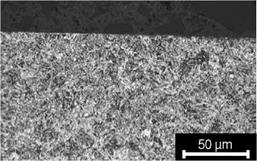Due to strain, steels destined for roller bearings have a high level of hardness (52 — 65 HRC), a high degree of purity, an even structural configuration and high resistance to wear. Chemical composition, melting and heat treatment are decisive for the obtainable structure and thus for the necessary properties of roller bearing steels.
In Germany, mostly hardenable steels are used, above all type 100Cr6 (table 45), while, in the US for example, case-hardened steels are used as roller bearing steels to a great extent.
|
Table 4-5. Composition of roller bearing steel 100Cr6
|
By heat-treating it, the steel acquires a martensitic and carbidic structure (Fig.
4- 9). In the case of supereutectoid steels, carbon content is so high that a full martensite hardness of 64 HRC can be reached, but 5 to 10 vol.-% non-dissolved secondary carbides still remain in the basic mass. Because of the increased hardness of these carbides as opposed to martensite, supereutectoid roller bearing steels can reach a hardness of 65 HRC. The hard carbides and the martensite structure have a strongly abrasive effect on the machining tools and thus lead to high resultant forces [N. N.98].
|
Fig. 4-9. Microsection of roller bearing steel 100Cr6, heat-treated |

